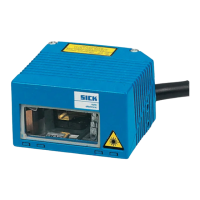“Ladder” Orientation Equation
Scan Frequency = (V x N) Number of Scans = H
––––––– –––– x SF
HV
“Picket Fence” Orientation Equation
Scan Frequency = (V x N) Number of Scans = (W - L) x SF
––––––– ––––––––––––
W-L V
Following is an example for calculating scan frequency for a bar code in “ladder” orientation:
- Conveyor speed (V) = 100 ft/min = 20 in/sec
- Bar height (H) = .5 in
- Printed bar code 100% readable (material, printing, surface)
- Optimal adjustment of CLV (reading distance, angle, resolution)
- Required scans per code (N) = 10
20 x 10
SF= ——–——-
0.5
SF= 400 Hz
10 to 15 scans per code is usually sufficient. Any further increase does not produce better reading results. However, slower scan
rates can help the scanner read codes that are harder to read. Some causes for this reduction are: a dusty lens on the CLV,
small minimum width of the bar code, or bar code quality (i.e. poor print contrast).
Code Position Read Zone
This function allows the user to create an electronic mask. The scan line of the scanner is divided into 100 positions called Code
Position (CP) values. By entering minimum and maximum CP values, you effectively create a reading zone within the scan line.
This is very useful when the spacing of the objects to be scanned is small. The valid choices are 0 to 100 in 1 value increments:
Minimum CP ...... 0 to 100 default 0
Maximum CP ...... 0 to 100 default 100
Software Configurations
28
SICK Optic-Electronic
Bar Code Scanners
3
= Scan frequency
= Label velocity (inches/second)
= Number of scans required
= Bar height
= Scan width
= Label length
SF
V
N
H
W
L
The following variables and
equations are valid:
Scan Frequency
Sets the scan rate of the scanner, from 200 to 800 Hz, in 50 Hz increments. The conveyor speed and the scanning frequency of
the CLV determine the number of reads theoretically possible per bar code. The higher the scanning frequency, the greater the
number of scans possible as the bar code passes the scanner (assuming a constant conveyor speed). With this information, a
large number of scans can be checked for agreement of information content. This increases reading reliability. The variable scan-
ning frequency thus enables the reading process to be optimally matched to the conveyor speed and the number of multiple
reads required. See following page for valid variable examples.

